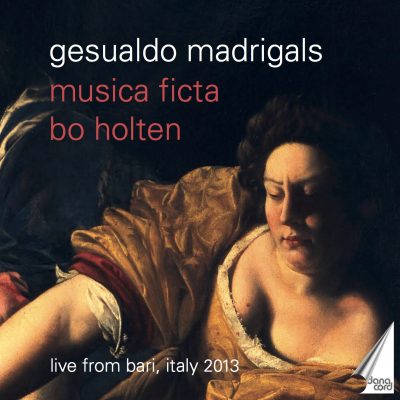
Gesualdo Madrigals – Live from Bari
DACOCD 760 · 2015
Musica Ficta
Singers
Ann-Christin W. Ingels, Susannah Carlsson, Amy Vestbø – sopraner
Sofia Thelin– alter
Tobias Aabye Dam, Josef Hamber – tenorer
Mauro Borgioni– basser
Bo Holten, dirigent
Tomas Borgström, Optagelse
Viggo Mangor, producer og teknik
Christian Tobiassen, manager
Indspillet ved Festival Mousiké, Bari, Italy 2013
»I have heard many interpretations of Gesualdo in my lifetime, many different ones, but I would place yours at the very top«.
Glenn Watkins
Carlo Gesualdo (1566-1613) is possibly the most extreme composer of madrigals ever. The madrigal as a genre was born in the first half of the 16th cent as a fusion between frivolous and simple Italian popular songs in three parts, and polyphonic writing coming to Italy through the great influx of learned Franco-Flemish composers. This fusion of traits from Northern and Southern thinking exploded in the production of more than 10.000 compositions featuring a more and more refined and illustrative writing, on texts by the most reknowned poets. Gesualdo’s madrigals appear near the end of the flowering of this tradition, and he expands the modes of expression quite considerably. Often people tend to think that his extreme music occurred as a result of his very eventful and dramatic life. And that might indeed be part of the explanation.
Other composers who excelled in Italian madrigals are Luca Marenzio, Giaches de Wert, Claudio Monteverdi and Luzzasco Luzzaschi. But this CD is all Gesualdo, in a live recording.
Previously it was generaly thought that Gesualdo wrote madrigals throughout his life, and that the “late” and extraordinary books 5 and 6 belonged to his last remorseful and tragic years in the Castle of Gesualdo. According to the research of Glenn Watkins, and to Gesualdo himself, he had already written all of his madrigals by the time he left Ferrara for the last time in 1597. We know, of course, that the very first complete printing of the madrigals comes from Gesualdo’s last year 1613, and that this printing was due to Gesualdo’s wish to have his musical legacy printed correctly, in an attempt to better the situation with many “pirated” and corrupt copies circulating. So his madrigals span only about a decade during which they undergo a remarkable development.
This development is easy to follow on this CD. From track 5 till the last track, one has a chronological progression with madrigals in the many different styles of each of the books. The reason we have placed a few of the late madrigals at the very beginning of the CD is of course that listeners would like to encounter the staggering adventures of the later books right away when putting on the CD. At the end of the CD we of course return to the madrigals of book 6 in order to have a complete survey of the maestro’s development as a madrigalist.
Bo Holten









